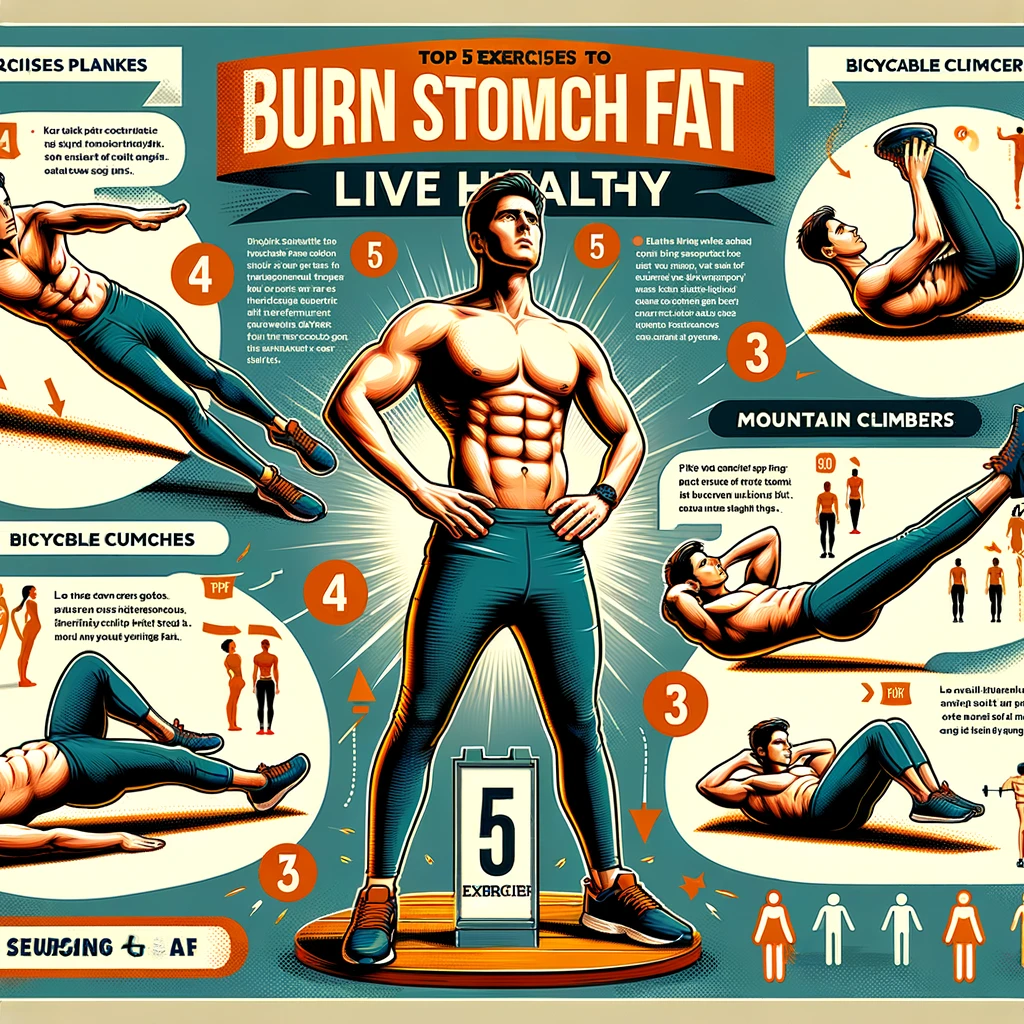Achieving a tight, toned stomach is a common fitness aspiration. Not only does it enhance aesthetics, but strong stomach muscles also improve posture and facilitate other exercises. Here, I’ll guide you through five effective bodyweight exercises for toning your abs and achieving your fitness goals.
The Significance of a Well-Balanced Diet
Before attacking the exercises, it’s essential to recognize that achieving a toned stomach is not solely dependent on physical activity. A well-balanced diet plays a crucial role in reducing body fat and revealing the abs you’ve worked hard for. Prioritize consuming whole, nutrient-rich foods such as lean proteins, fruits, vegetables, and healthy fats while minimizing your intake of processed foods, sugary treats, and excessive alcohol.
Exercise 1: Cycling Crunches
Cycling crunches are a challenging yet highly effective exercise for toning the stomach muscles. This movement combines traditional crunches with a cycling motion of the legs. To perform cycling crunches, follow these steps:
- Start by lying on your back with your legs extended, hands placed beside your head, and elbows pointing outward.
- Lift your legs off the ground, keeping your left leg straight while bringing your right knee towards your chest.
- Simultaneously, rotate your upper body towards your right knee, aiming to touch it with your right elbow.
- Rotate your upper body towards your left knee, attempting to touch it with your left elbow.
- Continue alternating legs and rotating your upper body for as many repetitions as possible.
- Take a one-minute break before repeating the exercise two more times.
Exercise 2: Front Planks
Front planks may appear simple, but they are incredibly challenging and provide a comprehensive workout for your core muscles. This exercise involves maintaining a straight, rigid position for an extended period. To perform front planks, follow these steps:
- Begin in a kneeling position on the floor, placing your forearms in front of you, parallel to your head.
- Extend your legs behind you, lifting your knees off the floor and balancing on your toes and forearms.
- Once you find your balance, engage your core muscles and hold the plank position for as long as you can maintain proper form.
Exercise 3: Lateral Planks
Lateral planks are a variation of traditional planks that target the oblique muscles by having you hold the position while lying on your side. To perform lateral planks, follow these steps:
- Lie on your left side with your left forearm on the floor and your right hand placed behind your head.
- Gradually lift your hips off the floor, balancing on your left forearm and the side of your left foot.
- Once you find your balance, engage your core muscles and hold the lateral plank position for as long as possible.
- Rest for one minute before switching to your right side and repeating the exercise.
- Perform the lateral plank on both sides two more times, taking a one-minute break between each set.
Exercise 4: Supine Leg Lifts
Supine leg lifts may appear simple, but they provide a challenging workout for your entire core. This exercise involves raising and lowering your legs while lying on your back. To perform supine leg lifts, follow these steps:
- Lie on your back with your hands placed near your glutes.
- Slowly lift your legs off the floor until they are perpendicular to the ground, forming a 90-degree angle with your hips.
- Gradually lower your legs back down, stopping just before your feet touch the floor.
- Repeat the movement for as many repetitions as you can manage.
- Take a one-minute break before completing two more sets.
Exercise 5: Supine Knee Tucks
Supine knee tucks are similar to supine leg lifts but involve bending your knees towards your chest instead of keeping your legs straight. To perform supine knee tucks, follow these steps:
- Start by lying on your back with your hands placed near your glutes.
- Slowly bend your knees, bringing them towards your chest until they are fully tucked in.
- Gradually extend your knees, stopping just before your feet touch the floor.
- Repeat the movement for as many repetitions as possible.
- Rest for one minute before completing two more sets.
By incorporating these exercises into your fitness routine and combining them with a balanced diet, you’ll be well on your way to achieving a strong, toned stomach.
Real-Life Examples
- Sarah, a 28-year-old office worker, incorporated bicycle crunches and planks into her daily routine. After 6 weeks of consistency, she noticed a significant improvement in her core strength and a reduction in her waistline.
- John, a 35-year-old father of two, struggled with belly fat despite regular jogging. He added lying leg raises and side planks to his workouts and adjusted his diet. Within 3 months, he achieved visible abs and felt more energized throughout the day.
- Emily, a 42-year-old stay-at-home mom, wanted to regain her pre-pregnancy stomach. She started with modified versions of lying knee tucks and gradually progressed to the full exercise. Combined with a balanced diet, Emily saw a noticeable difference in her stomach’s appearance and felt more confident in her own skin.
People, Also Searched
Can I do these exercises every day?
- A: While it’s essential to maintain consistency, it’s equally important to allow your muscles time to recover. Aim to perform these exercises 2-3 times per week, with at least one day of rest in between sessions.
How long does it take to see results?
- A: The time it takes to see visible results varies from person to person, depending on factors such as starting body composition, diet, and overall consistency. On average, you may start to notice changes within 4-6 weeks of regular exercise and proper nutrition.
Can I target belly fat specifically with these exercises?
- A: While these exercises effectively strengthen and tone the abdominal muscles, it’s impossible to spot-reduce fat from specific areas of the body. To reveal your toned stomach, focus on a combination of regular exercise and a balanced, calorie-controlled diet to reduce overall body fat percentage.
I have lower back pain. Can I still do these exercises?
- A: If you have pre-existing back pain, it’s always best to consult with your doctor or a qualified fitness professional before starting any new exercise routine. They can help you modify the exercises or recommend alternative movements that are suitable for your condition.
Final Thoughts
By practicing the exercises in this article once or twice per week, you’ll rapidly develop a set of strong, toned stomach muscles. Remember, a healthy diet and consistent exercise routine are essential for achieving and maintaining a strong, lean physique. Stay dedicated, stay patient, and enjoy the journey towards a healthier, more confident you.


